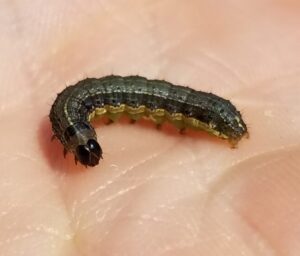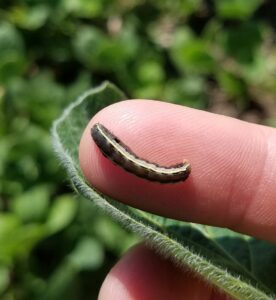Fall Armyworm in Pasture, Alfalfa, and Double-cropped Soybean

Over the last two weeks, reports of fall armyworm (Spodoptera frugiperda) activity in southern and western Illinois have been on the rise, with reports of severe injury in some cases. The Southern U.S. has had a big year for fall armyworm (you can read more about their experience here, as well as find links to additional control information from the states involved: https://www.dtnpf.com/agriculture/web/ag/crops/article/2021/08/02/fall-armyworm-invading-southern). This is a migratory pest, and moth flights have been arriving both earlier and at higher numbers than in previous years. This should put us on alert in pastures, alfalfa forage, late-planted soybean, and early planted wheat or small grain cover crops (not to mention lawns). Avoid confusing this insect with either the “true” armyworm (Mythimna unipuncta), which we are used to seeing in May-June in vegetative corn and other crops; in particular, note that fall armyworm is much more capable of causing meaningful defoliation in soybean than the true armyworm. In addition, the yellow-striped armyworm (Spodoptera ornithogalli), a relatively minor pest of soybean and alfalfa, seems to be present at above-average levels in Illinois this year.
Adding to the concern, our colleagues to the south have experienced control failures this year with pyrethroid insecticides, which in years past have typically been effective on fall armyworm in small grains, pasture grasses, soybean, and alfalfa. (Control issues with pyrethroids are not a new phenomenon in corn and sorghum). While I have not received reports of control failures yet in Illinois, these insects have migrated to Illinois from the south, so we should anticipate similar problems here. At minimum, if you have used a pyrethroid for fall armyworm control you should follow up with a field visit a few days later to see how it did. A better option might be to use a product containing chlorantraniliprole (e.g. Elevest, Prevathon, Vantacor, Besiege), methoxyfenozide (Intrepid 2F, Intrepid Edge), or spinosad (Blackhawk) using a material that is labeled for your particular crop.

As is usually the case when we see resistance to a pyrethroid, the price tags for these alternative are quite a bit higher. That being said, an ineffective application can be the most expensive of all. Make sure the damage done is truly worth the cost when making a control decision; the economic threshold in soybean post-bloom is 20% defoliation.
Author: Dr. Nick Seiter, Field Crop Entomologist | nseiter@illinois.edu | (812) 593-4317





